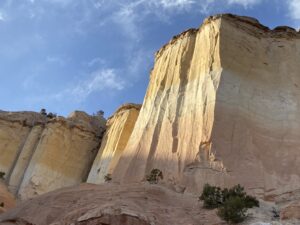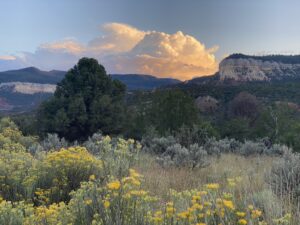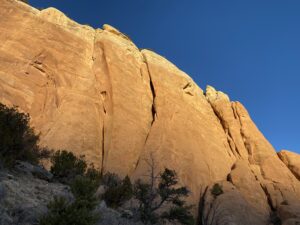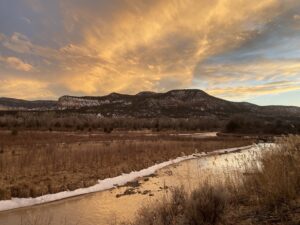All photos by Robert Kyr, from the Chama River Canyon area in New Mexico. Listen to music composed by Robert Kyr.
I FIRST MET ROBERT KYR during a visit to the Monastery of Christ in the Desert, a Benedictine community in a high desert canyon in northwestern New Mexico. On a lonely two-lane highway well north of Santa Fe, a small roadside sign reads, “Monastery 13 miles,” with an arrow pointing to a nondescript turnoff. The unpaved road starts tamely enough, but soon it swerves and narrows, tightly gripping the cliffs above the Chama River, with no guardrail or berm between it and the rushing water below. After forty-five minutes of car-rattling bumps, the monastery’s adobe chapel finally swings into view, its bell tower and clerestory windows visible against the reddish-brown mesas flanking the floodplain. Fragrant pinyon-juniper forest surrenders abruptly to a shrubby meadow where ravens soar overhead, croaking their gravelly messages. If the Benedictines who founded the monastery in the 1960s were looking for isolation and silence, they could hardly have chosen a better location.
I’ve negotiated that route many times to join the Benedictines on retreat. Late one summer, I spoke with a fellow retreatant, a tall man with a craggy, clean-shaven face who moved with graceful energy. He introduced himself as Robert Kyr, a composer who visited the monastery often. For all his directness, there was a measured shyness about him, a cautious reticence that, once overcome, unleashed a cascade of warmth, hospitality, and erudition. Kyr revealed that since 1993 he had been making annual forays to Christ in the Desert, where he had created more than sixty works, including symphonies, concerti, oratorios, and passions. Most of his Life unto Life cycle, an expansive seven-part work exploring Christ’s life from Annunciation through Ascension, has been composed there. Almost complete, it already comprises fourteen hours of music. Since first meeting, we’ve spoken about his work a number of times at the monastery, including an extended conversation in the summer of 2022.
We sit in chairs just outside the refectory, speaking in hushed tones as evening’s stillness settles on the canyon, Kyr describing his new compositions and upcoming recordings while I share some recent poems. “I feel inspired here in a way I do nowhere else,” he says, “because it includes being close to nature and to the monastic community and chanting some of the hours with them each day. It means living a life of wholeness with a heightened awareness of what it means to be alive. At night, there is minimal surface light, and when I look up, I see the heavens—the joy and wonder of our world and the universe.”
The experience of Christ in the Desert offers much that is essential to Kyr’s life and career: natural beauty, a peaceable community whose members strive to live in harmony with the divine and one another, a place where one hears the complex interplay of sound and silence. For Kyr, it all becomes part of his creative process.
“So many of the metaphors in the texts I’ve written emerged from living there,” Kyr says, most notably in his “environmental oratorios,” A Time for Life (music, 2010; film, 2020) and Earth Ritual (multimedia, 2022). “For Earth Ritual,” he explains, “I took more than 12,500 photos of the canyon in which Christ in the Desert is situated, a microclimate with two mesa ranges flanking a vast floodplain. I know this ecosystem extremely well, and it’s woven directly into the oratorio.”
More than a composer, Kyr is also a writer, photographer, videographer, filmmaker, interdisciplinary artist, educator, performer, and dedicated environmentalist. Born and raised on the west side of Cleveland and educated at Yale, the Royal College of Music in London, the University of Pennsylvania, and Harvard, he is a professor of music composition and theory at the University of Oregon’s School of Music and Dance. A devoted teacher, he also directs the Oregon Bach Festival Composers Symposium, the Music Today Festival, the Oregon Composers Forum, and the Vanguard Concert and Workshop Series. Moreover, he is the mentor and composer-in-residence for the Harvard Choruses New Music Initiative. In each of these capacities, he is devoted to encouraging the creation of new music by composers of all ages.
Kyr’s creative output over five decades is, by any standard, massive. He has composed twelve symphonies, three violin concerti, a piano concerto, numerous chamber works, including three chamber symphonies, and a dizzying array of vocal works ranging from small ensemble pieces to full-length oratorios and passions. All of these have been premiered, and numerous works are available on compact disc, such as his oratorios Songs of the Soul and Paradiso, his Violin Concerto Trilogy, his Passion according to Four Evangelists, and his cantata Unseen Rain.
While he is among the twenty-first century’s most significant composers, he is all but impossible to characterize. Asked what school or style he identifies with, he politely demurs, describing his work as drawing on a long lineage of composers “whose inner life is resonant in my own music.” For Kyr, that lineage begins with Hildegard von Bingen (born c. 1098), whom he calls “one of the most spiritually aware and inspired composers in history. She was the source of much that came after, even for composers who may not have known her or heard her music. Somehow, she tapped into archetypes of great strength and power.”
Kyr then traces, in precise chronological order, those whose music transmitted that flame, from twelfth-century innovators of sacred polyphony through the late nineteenth century and thereafter. He pauses to give special praise to two great Renaissance composers, Guillaume Du Fay and Josquin des Prez, and “above all” to Johann Sebastian Bach, whom he considers his primary spiritual influence.
His list continues with admiration for Haydn, Mozart, Beethoven, Schubert, Schumann, and Brahms. With equal enthusiasm, Kyr goes on to recognize other composers whose music has provided different kinds of inspiration, including Mahler, Stravinsky, Bartók, and Messiaen. In the 1970s, he explored the avant-garde at festivals such as Darmstadt, renowned as an international forum for contemporary and experimental music. For six years during the nineties, Kyr also had a career as an improvising pianist.
At the same time, his work embraces world music traditions. Since 1991, Kyr has directed a Balinese gamelan ensemble, the Pacific Rim Gamelan, which he founded as an orchestra in which each musician is both a composer and performer. The Balinese gamelan consists of metal xylophones and gongs tuned in a five-note mode. However, no two bronze keys are tuned to the same frequency, making a sound rich in “difference tones.” The result is a sonic shimmer unlike anything in Western music. Kyr’s Pacific Rim Gamelan is also a “world orchestra” (a term he coined), an ensemble for which composers create works that combine the gamelan with instruments from around the globe. Kyr teaches such forms of “intercultural composition” at the University of Oregon School of Music and Dance.
What thread links the creators in Kyr’s centuries-long musical lineage? He explains, “At the root of it all is a relentless search for spiritual truth. The art of each composer is grounded in the divine, the spiritual source from which the music emerged, becoming accessible to us through the fullness of its expression in sound.”
When asked how his music relates to that lineage, he identifies three streams: “conflict and reconciliation,” which is peacemaking; “the environment and living in harmony with nature,” which relates to global climate change; and “the spiritual themes of love, compassion, and forgiveness,” without which the other two streams grow stagnant.
Many of the composers in Kyr’s inspirational lineage are known for their vocal music. Some of the earlier figures, like Hildegard and Guillaume de Machaut, were poets as well, setting their own words to music rather than using preexisting texts. Some of Kyr’s vocal compositions are settings of contemporary poems, including several collaborations with his late friend Denise Levertov.
Kyr places his choral texts in two categories. The first he calls “text for music,” in which he writes words and music simultaneously, with no separation between the words and their expression in sound. These include several tracks from Kyr’s latest CD release, In Praise of Music, recorded by the Antioch Chamber Ensemble (Joshua Copeland, director), featuring ten choral works created over a twenty-year period, many of them using Kyr’s own texts, including paraphrases of John Donne and Saint Francis of Assisi.
Kyr’s second category, “composite text,” weaves excerpts from various sources into a unified libretto. His environmental oratorio A Time for Life combines North American indigenous prayers, songs, and chants; Orthodox liturgical texts; biblical passages; and texts he wrote himself. The CD recording was blessed by the Orthodox archbishop of Constantinople, Bartholomew I, often known as the “green patriarch” for his ongoing focus on our planet’s ecological crises. It also features an introduction by noted Orthodox eco-theologian John Chryssavgis. Kyr calls it a “musical play” in three acts—Creation, Forgetting, and Remembering. The music focuses the archetypal journeys of eight singers into an urgent plea for earth’s survival.
“I was reading texts of Native American chants and songs, and I was deeply moved when I realized how they are spiritually related to texts of the Eastern Orthodox liturgy. Even though there is no direct interaction between these geographically isolated cultures, they share the same concerns for preserving creation through living in harmony with nature. For me, this is a living manifestation of the connection of all human beings—there is one human family, connected in spirit. Moreover, since all cultures have some form of music, music is one of the primary life forces connecting all humans on the planet.”
The Passion according to Four Evangelists (1995) is another composite text. Two major late-twentieth-century passion settings, Krzysztof Penderecki’s Saint Luke Passion (1966) and Arvo Pärt’s Passio Domini Nostri Jesu Christi secundum Joannem (1982), followed the custom of selecting one Gospel, sometimes adding reflective asides and commentary, as in Bach’s Saint Matthew Passion. In contrast, Kyr harmonizes all four Gospels in his own English version, freely adapted from more than a dozen translations. He structures the passion narrative into three parts: Judgement, The Way of the Cross, and Crucifixion. This framework allows him to emphasize the role of women, placing Jesus’s encounter with the women of Jerusalem at the center of the second part, at the heart of the entire composition.
At the end of the passion, long after the apostles have fled, Psalm 88’s cry of desolation is sung by the faithful women: soprano and alto soloists with women’s chorus. Finally, joined by the men, they sing Psalm 130 (“Out of the depths, I cry to you”), followed by a brief epilogue by singers and orchestra foreshadowing the resurrection. Kyr allows the narrative to sound clearly and resolutely, each poignant note distinctly rendered, the music never overwhelming. The result is intimate and harrowingly beautiful.
Kyr’s latest CD is his hour-long setting of the Orthodox All-Night Vigil, recorded by Cappella Romana (Alexander Lingas, director). While the vigil was introduced to Western audiences through Rachmaninoff’s 1915 work set in Church Slavonic, Kyr’s work uses a new English translation by Father Ephrem Lash. The 2022 composition captures the spiritual profundity of the liturgical text and recalls the ethereal quality of Rachmaninoff’s famous a cappella rendering. Once again, Kyr’s music rewards the listener with its lyricism and beauty, inviting reflection and contemplation.
Though I’ve so far focused on Kyr’s choral works, his output is evenly divided between instrumental and vocal music. Growing up in Ohio, he familiarized himself with the standard orchestral repertoire, attending dozens of concerts with the Cleveland Orchestra directed by George Szell. It wasn’t until the eighties that Kyr began composing vocal music, releasing a flood of creativity that has yet to slow. Even his instrumental music often betrays a fascination with the human voice. On the Nature of Love (1997), the first work in Kyr’s Violin Concerto Trilogy, is composed for solo violin and string orchestra, comprising a theme and thirteen variations on the nineteenth-century shape-note hymn “What Wondrous Love Is This.” As the concerto unfolds and the hymn tune is transformed, the music grows ever more ecstatic, almost daring listeners to sing along.
Kyr’s second violin concerto, On the Nature of Harmony, combines solo violin, Western chamber orchestra, and Balinese gamelan. In the first movement, he juxtaposes the shimmering quality of the gamelan with the radically different sound of Western instruments. Over the course of the second movement, the sonic worlds begin to merge, culminating in the finale’s exuberant synthesis of East and West. He comments, “In this concerto, the instruments rejoice in their commonality. Ultimately, there is no separation. There is only one music. In uniting their similarities and differences, a surprising harmony arises through the act of artistic creation.”
Seeking and rejoicing in commonality comes naturally to Kyr. Born seven years after the end of World War II, he grew up listening to men in his extended family share their wartime stories. “I knew that wasn’t me,” he recalls. “I didn’t know the name for it at the time, but I was a pacifist from a very young age.” Kyr was in his mid-teens when his mother, who had worked for the International Red Cross in postwar Germany, disclosed that she had assisted US military officers in documenting what happened in the Nazi death camps and depots of chemical and biological weapons. Her work was highly classified, and the only person she ever shared it with was Robert, “because she was convinced that I would do something to address human suffering and the injustice of it.”
“It was only once that she spoke about it to me, lapsing into silence at a point beyond which nothing more could be uttered. It was as if she were lost in the immensity of what she had witnessed through transcribing the testimony of those who perpetrated it,” Kyr explains. “In time, I committed myself to help in any way that I could, by striving to become a force for peace through artistic creation.”
One of the composer’s most remarkable projects is a co-creation with Kazuaki Tanahashi, a respected Zen teacher, brushstroke artist, and writer. “The Nagasaki Peace Museum asked us to co-create a symphony on the theme of ‘weapons of mass destruction.’ This collaboration resulted in my tenth symphony, Ah Nagasaki: Ashes into Light (2008). Kaz insisted on writing the text first in English before translating it into Japanese so we could shape it together as ‘text for music.’” The symphony is written for double chorus and two orchestras, with each chorus singing primarily in English or Japanese. Over the course of the work, the choruses gradually move closer together, finally becoming one ensemble, singing Japanese and English as a shared meta-language—a sonic vision of peace and reconciliation.
In the late nineties, prior to the Nagasaki collaboration, Kyr started a four-year project titled “Waging Peace in the New Millennium,” issuing an international call for composers to create works on the theme of reconciliation and peacemaking. Shortly after the call for scores was announced, the terrorist attacks of September 11, 2001, occurred. Not knowing what to expect, Kyr and his colleagues were astonished to receive 718 pieces of music. “Music not only connects us to the deepest places within ourselves, but it calls us together,” he reflects. “For example, in a chorus, we are invited to sing in harmony as one human family, a celebration of our diversity and unity. My hope is that the music of our time will inspire and motivate people to take meaningful action wherever they are: for their family, their neighborhood, their city, their region, and for the planet.”
Kyr’s hopes return my thoughts to the monastery where we first met. Over his long acquaintance with the Chama wilderness and its rhythms, Kyr has witnessed the local effects of climate change in the form of an extended drought punctuated by torrential rains and floods. The canyon—or one resembling it—features prominently in his multimedia environmental oratorio Earth Ritual (2022). Combining photos, video, instrumental ensemble, chorus, and vocal soloists, Kyr immerses the listener in a story in which two characters, Alesha (soprano) and Tallis (baritone)—a writer and a filmmaker—nearly lose their lives to the forces of nature thrown out of balance by humanity. Through shared trauma, the pair glimpse the beauty and fragility of our common home as well as the need for human connection through the communal work necessary to heal our threatened planet.
When I listen to the oratorio, I see the canyon in my mind. I hear the soundscape from which Robert created such a moving plea for ecological awareness and urgent action. That, I suppose, is as it should be, since the Chama has, in his own words, “flowed into nearly every piece I’ve written since 1993.” The canyon grounds and unifies the manifold talents, fascinations, and passions of this intensely busy soul. To view Kyr without it would be like imagining Sibelius without Finland or Charles Ives apart from New England. It can be done, I suppose, but we lose something essential. As for Robert Kyr, I trust he will return to the monastery and the canyon for many years to come, blessing a wounded world with the truth, harmony, and peace he finds there.
All photos by Robert Kyr.
Brian Volck is a pediatrician who lives in Baltimore. He has published one volume of poetry, Flesh Becomes Word (Dos Madres), and a memoir, Attending Others: A Doctor’s Education in Bodies and Words (Cascade).










